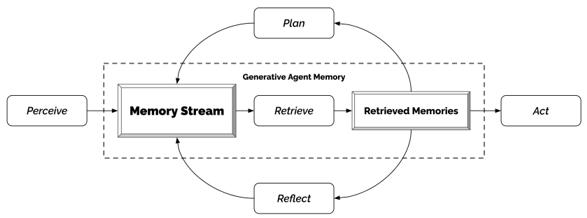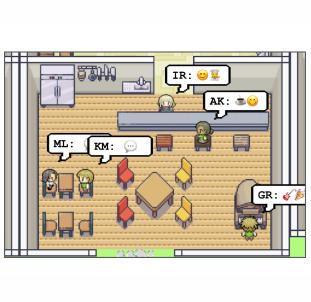| AI Agents Organize A Party |
| Written by Sue Gee |
| Sunday, 23 April 2023 |
|
Taking inspiration from The Sims, researchers from Stanford University and Google have created computational software agents that simulate believable human behavior. Generative agents can interact with each other, can plan ahead and can remember and reflect on what they have done, all powered by ChatGTP. In an arxiv paper the researchers introduce generative agents as being just like us: Generative agents wake up, cook breakfast, and head to work; artists paint, while authors write; they form opinions, notice each other, and initiate conversations; they remember and reflect on days past as they plan the next day. Just as humans do, generative agents use natural language for their thought processes and their interactions and the paper details how the researchers devised an architecture connected to the ChatGPT large language model to store a complete record of the agent’s experiences using natural language, synthesize memories over time into higher-level reflections, and retrieve them dynamically to plan behavior. The paper also explains how the researchers created a sandbox environment, reminiscent of The Sims. Called Smallville the village has houses and a college dorm,a supply store, a grocery/pharmacy, a bar, a cafe, a park and a co-living space where people can get together. Twenty-five agents, each with an identity provided in a single paragraph of natural language description inhabit Smallville By interacting with each other, generative agents in Smallville exchange information, form new relationships, and coordinate joint activities and these social behaviors are emergent rather than pre-programmed. The paper recounts that, starting with only a single user-specified notion that one agent wants to throw a Valentine's Day party, the agents autonomously spread invitations to the party over the next two days, make new acquaintances, ask each other out on dates to the party, and coordinate to show up for the party together at the right time. In the paper, the researchers argue that generative agents have vast potential applications that extend beyond the sandbox demonstration presented in this work and that by utilizing generative agents as proxies for users, it would be possible to develop a deeper understanding of users needs and preferences, resulting in more personalized and effective technological experiences. The conclusion reached is that the architecture creates believable behavior and that in future generative agents will be able to play roles in many interactive applications ranging from design tools to social computing systems to immersive environments.
More InformationGenerative Agents: Interactive Simulacra of Human Behavior by Joon Sung Park, Joseph C. O'Brien, Carrie J. Cai, Meredith Ringel Morris, Percy Liang, Michael S. Bernstein ChatGPT: Optimizing Language Models for Dialogue Reuters - ChatGPT sets record for fastest-growing user base Related ArticlesGoogle's Large Language Model Takes Control Chat GPT 4 - Still Not Telling The Whole Truth The Unreasonable Effectiveness Of GPT-3 To be informed about new articles on I Programmer, sign up for our weekly newsletter, subscribe to the RSS feed and follow us on Twitter, Facebook or Linkedin.
Comments
or email your comment to: comments@i-programmer.info |
| Last Updated ( Sunday, 23 April 2023 ) |




